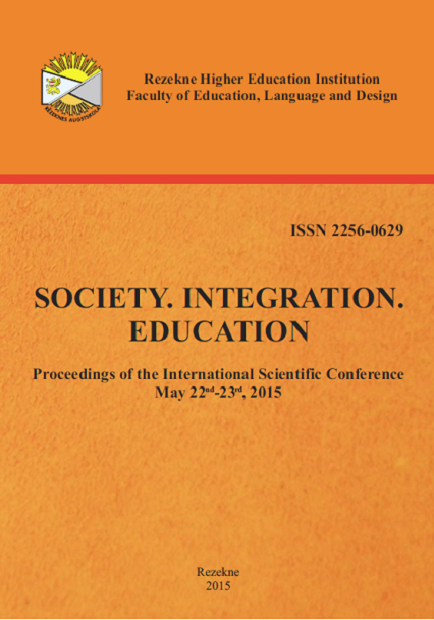Aaerobic Capacity of Health Care Students at Riga Stradinš University
DOI:
https://doi.org/10.17770/sie2015vol3.472Keywords:
Aerobic capacity, students, health care studentsAbstract
Aerobic capacity (AC) is one of health indicators that characterise the functional status of heart, blood vessels, respiratory and other bodily systems. Aerobic capacity depends on several factors: the health conditions, gender, age and the level of physical activities. Students spend many hours in a sitting position in lectures, libraries, when preparing homework, as well as when watching the TV and sitting by the computer. As a result students’ work abilities decrease and the health conditions deteriorate. Health care specialists should be physically active, not only for the sake of their well-being and health conditions, but also they should to be able to motivate their clients to have an active lifestyle.
Objective of the research. The objective of the research is to explore aerobic capacity of healthcare students and analyse it within the context of the respective age group population. Aerobic capacity was determined for 730 students (517 women and 213 men in the age group from18 to 30 years) by applying the veloergometry test of the World Health Organisation (WHO) and using veloergometersMonarkErgomedik 839E. Pursuant to the WHO test results during the studies aerobic capacity indicators deteriorated for the majority of students.
Downloads
References
Arnis, V., Horna-Butkeviča, A. (2003). Studentu fiziskās darbspējas un to izmaiņas studiju laikā. Rīgas Stradiņa universitātes Zinātniskie raksti. Rīga, RSU, lpp.153-156
Arnis, V., Horna-Butkeviča, A., Vinberga, I. (2004). Aerobo darbaspēju paaugstināšanas iespējas ar precīzi dozētām slodzēm. Rīgas Stradiņa universitātes Zinātniskie raksti. Rīga: RSU, 190 - 193. lpp.
Biedrība „ Latvijas Augstskolu sporta savienība” (2012). Izglītības un zinātnes ministrijas 06.16.00 programmas „ Izglītības sistēmas vadības nodrošināšana” Pētījuma socioloģiskās aptaujas Studentu un jauniešu sportošanas paradumi. Iegūts no http://izm.izm.gov.lv/upload_file/petijumi/Petijuma_atskaite_LASS.pdf
Bianchini, de Quadros T. M., Petroski, E. L., Santos-Silva, D. A. et al. (2009). The prevalence of physical inactivity amongst Brazilian university students: itsassociationwithsociodemographicvariables. Rev. saludpública.; 11 (5): 724-733.
Chevan, J., Haskvitz, E. M. (2010). Do As I do: Exercise Habits of Physical Therapists, Physical Therapist Assistants, and Student Physical Therapists. Physical Therapy.; 90(5):726-734.
Irwin, J. D. (2007). The Prevalence of Physical Activity Maintenance in a Sample of University Students: A Longitudinal Study. Journal of American College Health. 56(1): 37-41.
Kwan, M.Y.W., Bray, S.R., Martin Ginis, K.A. (2009).Predicting Physical Activity of First-Year University Students: An Application of the Theory of Planned Behavior. Journal of American College Health. 58(1):45-52.
Love, L. K., LeBlanc, P. J., Inglis, I. G. et al. (2011). The relationship between human skeletal muscle pyruvate dehydrogenase phosphatase activity and muscle aerobic capacity. Journal Of Aplied Physiology.; 111(2): Pp 427-434.
Latvijas iedzīvotāju veselību ietekmējošo paradumu pētījums, FINBALT, (2012).
Madanat, H., Merrill, R. M. (2006).Motivational factors and stages of change for physical activity among college students in Amman, Jordan. Promotion & Education. 13(3):185-190.
Magutah, K, Takahashi, R, Wilunda, C.(2012).Academic Exposure to Benefits of Physical Fitness Does Not Give Medical Students an Edge over Students from Non-Health-Related Disciplines. Journal of Applied Medical Sciences. 1(2): 61-67.
McArdle, W. D. (2007). Exercise Physiology: energy, nutrition and human performance. Philadelphia, 1068p.
Mitchell, S. D., Eide, R., Olsen, C. H. et al. (2008). Body Composition and Physical Fitness in a Cohort of US Military Medical Students. JABFM. 21:165–167.
Park, S., Kim, J. K., Choi, H. M. et al. (2010).Increase in maximal oxygen uptake fallowing 2- week walk training with blood flow occlusion in athletes. European Journal of Applied Physiology. 109 (4): Pp 591- 600.
Physical Activity [tiešsaite]. WHO, (2011). – [atsauce 18.04.2013.] // www.who.int/topics/physical_activity/en/
Rao, C. R., Darshan, B. B., Das, N. et al. (2012). Practice of Physical Activity among Future Doctors: A Cross Sectional Analysis. Int J Prev Med. 3(5): 365–369.
Rees, R., Kavanagh, J., Harden, A. et al. (2006).Young people and physical activity: a systematic review matching their views to effective interventions. Health Education Research. 21(6):806-825.
Rezaimakesh, D., Akuiri-Farscani, P. (2004).The effect of a six week aerobic intermittent swimming on VO2 max and some lung volumes and capacities in students athletes.Procedic-SocialandBehavioral Sciences. 15:Pp 2054- 2057.
Sauka, M., Priedīte, I. S., Artjuhova, L. et al. (2011).Physical fitness in northern European youth: Reference values from the Latvian Physical Health in Youth Study. Scandinavian Journal of Public Health. 39(1):35-43.
Scharhag-Rosenberg, F., Meyer, T., Walitzek, S., Kindermann, W. (2010). Effects of one year aerobic endurance training on resting metabolic rate and exercise fat oxidation in previously untrained men and women. International Joutnal Of Sports Medicine. 31(70):Pp 498-504.
Schjerve, I. E., Tyldum, G. A., Loennedren, I. P. et al. (2008).Both aerobic endurance and strenght training programmes improve cardiovascular health in obese adult. Clinical Science. 115(9): Pp 283- 193.
Shvartz, E., Reibold, R. C. (1999). Aerobic Fitness Norms For Males And Females Aged 6-75: A review. Aviation, Space and Environmental Medicine. 61: 3-11.
Strath, S., Hill, K., Spitzer, M. R. (2009).Aerobic endurance exercise benefits memory and effect in young adults. Neuropsychological Rehabilitation. 19(2): Pp223- 243.
Taliaferro, L. A., Rienzo, B. A., Pigg, M. R. et al. (2009).Associations between Physical Activity and reduced rotes of hopelessness, depresion and suicidea behavior among college students. Journal of American College Health. 57: Pp 427- 434.
Warburton, D. E. R., Nicol, C. W., Bredin, S. D. S.(2006). Health benefits of physical activity: the evidence. CMAJ.174(6): 801-809.
Феофилактов, В.В.(2005). Сравнительный анализинновационных технологий физической подготовки студентов гуманитарных вузов на основе мониторинга физического развития. Iegūts no: Научная библиотека диссертаций, авторефератов http://www.dissercat.com/content/sravnitelnyi-analiz-innovatsionnykh-tekhnologii-fizicheskoi-podgotovki-studentov-gumanitarny#ixzz2FQy46Iko


